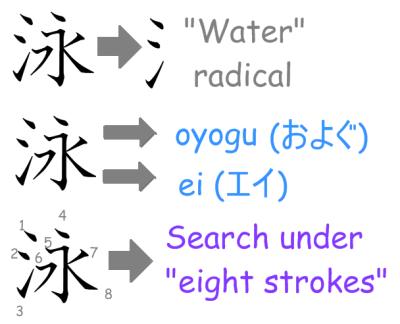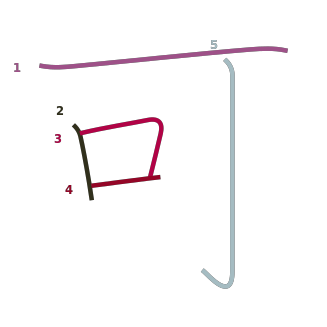
 |
| Three ways of looking for a kanji |
|---|
A kanji dictionary is used to look up a word for which one only knows the kanji, not the pronunciation. There are three main ways to search for a word in a kanji dictionary.
The first way is via the radical of the kanji. One identifies a part of the kanji which is common to several characters, and then one looks at the radical index of the dictionary to find the page containing all the kanji which contain this radical. The radical index is often inside the front cover of a kanji dictionary. What are kanji radicals? has more on the radical system, and What are the names of the kanji radicals? has a complete list of the usual radicals.
The second way is via the pronunciation of the kanji. Since kanji may have more than one pronunciation, one may look up a kanji with an unknown pronunciation by searching for it under another pronunciation. For example, if one does not know the on-yomi of a kanji, one may look it up using the kun-yomi. All kanji dictionaries have a pronunciation index, usually at the back. In many kanji dictionaries, on readings are shown in katakana, and kun readings are shown in hiragana. Why do kanji have several different pronunciations? has more about on and kun readings.
The third way of searching is via the total stroke count of the kanji. This involves counting the number of strokes in the kanji in the kaisho form (see Handwritten styles). All kanji dictionaries have an index by total stroke count. However, this may be tedious. The number of strokes of kanji varies between one and about thirty, and most kanji dictionaries have at least four thousand entries, so it involves looking at around one hundred or more kanji to find the right item.
The difficulty of correctly counting strokes adds to the effort required. For example 可 contains five strokes, not four or six. The square at the centre counts as three strokes, despite having four lines, because the upper left inverted L shape counts as one stroke, and yet the upper left inverted L shape surrounding the character is two strokes.

Since none of these systems is perfect, many people have invented different methods of looking up kanji. For example, the Four-Corner Method was invented in China in the 1920s and it is based on looking at the corners of the kanji. See the FAQ's four-corner method lookup for links containing more information, as well as an online lookup.
Many authors of kanji to English dictionaries have come up with their own methods of looking up kanji. Alternatives to the traditional radical/stroke count methods include:
In addition to these methods, computer technology has also allowed new methods of lookup via handwritten kanji, such as the FAQ's handwritten input, or via multiple radicals, such as the FAQ's multiradical lookup. These are often useful to fill in gaps where it is difficult to find characters via the traditional radical/stroke count system.
Copyright © 1994-2025 Ben Bullock
If you have questions, corrections, or comments, please contact Ben Bullock or use the discussion forum / Privacy policy

|

|

|

|

|
| Book reviews |
Convert Japanese numbers |
Handwritten kanji recognition |
Stroke order diagrams |
Convert Japanese units |